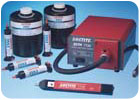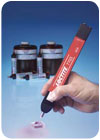Ready, Thermoset, Go!

In case you didn't know, thermoset adhesives are everywhere - in airplanes, automobiles, our homes and the buildings we work in - and for good reason. Unlike their molecular cousins (thermoplastics), these crosslinked polymeric resins offer a durable cure that will not melt or flow when exposed to high temperatures. Thermoset adhesives also boast better fluid and environmental resistance than thermoplastics, making them the ideal choice for a range of structural and mechanical applications. Want to make sure your bolts stay fixed in place? Try an anaerobic threadlocker, a thermoset that cures without oxygen in the presence of metal ions. Or maybe you've got a delicate electronics assembly that requires a little more finesse than, say, the standard caulking gun has to offer. Sounds like a job for a UV B-staged adhesive. Truly, the manufacture of thermoset adhesives is a big business - and it's only getting bigger.
For this article, we spoke to representatives of 3M and Henkel for some insight into how their companies approach the thermoset adhesives market, as well as to find out what product innovations we can expect in the near future.
Working with the Customer
According to Scott Buss, product manager, 3M™ Scotch-Weld™ Adhesives, Industrial Adhesives & Tapes Division, ease-of-use is the overarching theme behind his company's many innovations in the thermosets market. "We need to support how our customers want to manufacture," Buss says. "They want to enhance their production through productivity gains that minimize the number of steps it takes to assemble their products, so we need to consider that when we design adhesives."Another concern for 3M is making sure its thermoset offerings are compatible with the substrates that its customers are using. With assemblies trending toward lightweight, low-cost materials (plastics, polypropylene, polyethylene), Buss says it's not uncommon to find that primers or some other sort of special preparation are needed for affixing to new substrates.
Though 3M products serve a range of markets, thermoset use has been particularly prevalent in the industrial, aerospace and electronics sectors. Following is a list of recent 3M product innovations for each industry.
Industrial
For industrial applications, the company now offers 3M Scotch-Weld Polyurethane-Reactive (PUR) Easy Adhesive System, a lower-temperature system that dispenses PUR adhesive at 170°F as opposed to the traditional dispense temperature of 250°F. This allows for the use of plastic nozzles, thus making dispensing equipment easier to maintain. Lower temperature also allows for better adhesive stability and longer pot-life, which in turn frees customers to concentrate on assembly rather than worrying about the quality of their adhesive.
Aerospace
3M Scotch-Weld AF555 film is an epoxy film adhesive oriented toward new composite materials being used to slim down and reduce the weight of airliners (i.e. the new Boeing 787), thus making them more fuel efficient.
Electronics
New UV B-Stage Paste Adhesive technology from 3M is optimized for high-volume stencil printing applications. After printing, brief exposure to UV light "freezes" the adhesive in place, eliminating the slump and bleed-out commonly associated with thermoset paste adhesives. Once the adhesive has been applied and B-staged on a substrate, the second substrate is mated to the first and a thermal cure cycle yields fully crosslinked, void-free bonds. This adhesive technology enhances productivity and has the potential to be used in a range of electronic applications, including die-attach and flex-stiffener bonding. Buss says that 3M's approach to growing its thermoset business consists of working with its customers to find easier ways to assemble their products. This extends to developing not only better delivery systems but also better curing methodologies for its adhesives.

Perfecting Product Development
Like 3M, Henkel is a leader in the development and manufacture of thermosetting adhesives with applications in a range of industries. In fact, the company - famous for its Loctite® products - is acknowledged as the largest manufacturer of industrial adhesives in the world.According to John Cocco, global vice president of Product Development for Henkel's Industrial Assembly Division, his division specializes in five basic categories of thermosetting materials: anaerobics, epoxies, silicones, polyurethanes, and acrylics. Ultimately, Henkel's goal (and it's a familiar one) is to make products that are as customer-friendly as possible.
"Our efforts are focused on going into industry segments globally and doing Voice of Customer analyses," Cocco says. "Customers want robust materials that are easy to specify, predictable, and reliable over the life of an assembly, both in production and in end use."
Though Henkel's offerings run the gamut of traditional thermoset formulations (two-part epoxies, heat-curing silicones, moisture-curing polyurethanes), the company has put particular emphasis of late on its radiation-curable line of products. Having blazed this trail since the mid 1970s, Henkel has more than a passing familiarity with the rad-cure process, but it wasn't until a few years ago that certain product innovations effectively lowered the initial cost of implementing a rad-cure system, thus allowing more companies to reap very real economic benefits through the use of rad-cure adhesives.
Take Henkel's LED-based curing systems, for example. Rather than investing in expensive activator lights and bulbs and potential workspace renovations to accommodate ventilation (as did the rad-cure customers of yore), users of Henkel's LED-based curing systems can buy a LED-based light with a >10,000-hour bulb that cures in the visible light spectrum for around $1,000, making both ventilation and bulb replacement things of the past.

"The Visible Light line is going to take the cost factor for equipment out of the equation and make things safer," Cocco says. "As far as glue per pound is concerned, the cost might not change that much. From a production person's standpoint, though, it's a very good thing."
Also causing a stir at Henkel is the launch of its new Delayed-Cure (or Pre-Activated) Adhesive. Unlike traditional rad-cure adhesives, this product can be activated before application and assembly, therefore allowing it to cure in the dark.
Taken as a whole, the above examples are indicative of an approach that has made Henkel a world leader in thermoset adhesives market. Says Cocco, "If you look at the sum total of our product development programs, probably half of them concern developing products that cross all chemistries, thereby making it easier for our customers to produce consistent product. The other half focus on pushing the performance envelope of the materials further out."

Summary
Already lauded for the inherent reliability and durability of their formulations, thermoset adhesives are making bold strides into new areas of application thanks to ease-of-use initiatives and technological innovations spearheaded by companies like 3M and Henkel. In addition, the costs associated with certain thermoset processes have come down considerably in recent years, making thermosets a viable alternative to current assembly practices. Of course, all of these considerations beg an important question of manufacturers the world over: If you aren't using thermoset adhesives as part of your assembly process, what are you using?AUTHOR'S NOTE: For a general discussion on the difference between thermoset and thermoplastic adhesives, see Dr. Dave Dunn's Q&A Exchange on page 82.
Looking for a reprint of this article?
From high-res PDFs to custom plaques, order your copy today!




